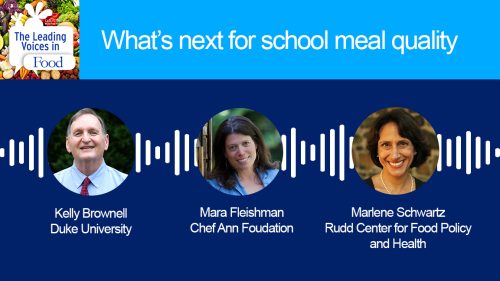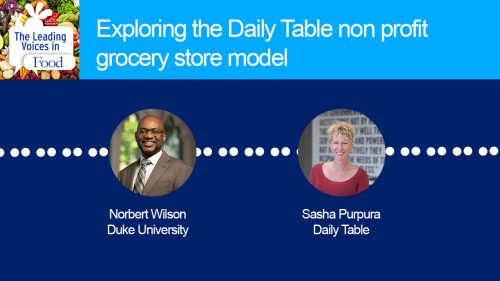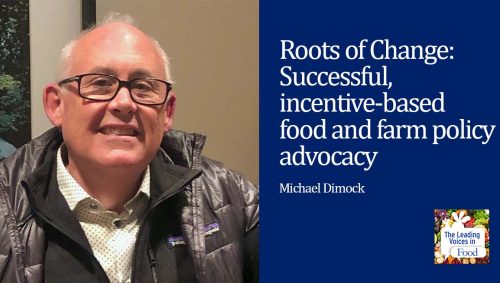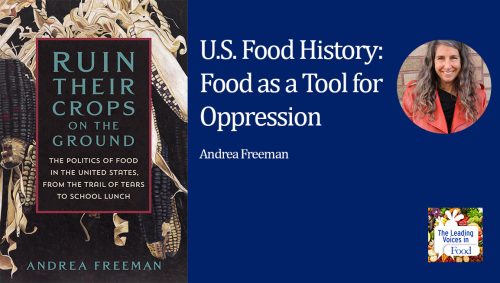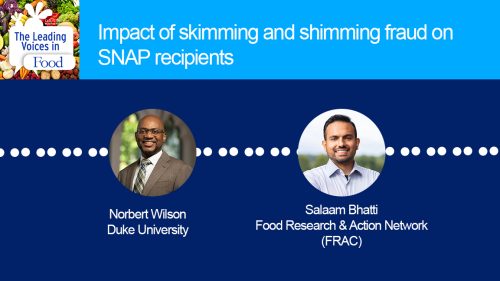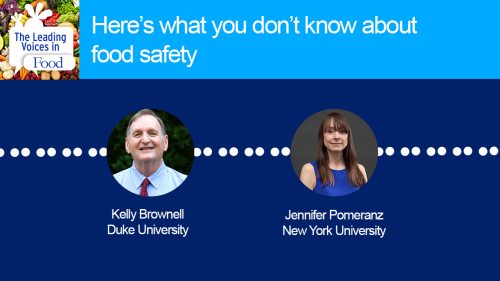The Leading Voices in Food
E253: Learnings from No Kid Hungry in New York
When we talk about problems with food insecurity and the food system, we tend to reference challenges at the national or international level. And of course, work at that level really needs to be done. But increasingly, there is a unique focus on regional food system strategies and right sizing solutions to best fit those unique characteristics of a particular locale. In today’s podcast, we will talk with Rachel Sabella, director of No Kid Hungry New York. She leads the planning, implementation, and evaluation of the No Kid Hungry campaigns across the state of New York.
Subscribe: Apple Podcasts | TuneIN | YouTube Music | SoundCloud | PocketCasts | Radio Public
Tags: Child Development & Nutrition | Community & Economic Development | Equity, Race & Food Justice | Food Policy |

Rachel Sabella has been a respected advocate, strategist and leader for nonprofit organizations for more than 20 years. She has been the Director of No Kid Hungry New York, a campaign of Share Our Strength, since 2018. In this role, Ms. Sabella works closely with stakeholders across New York State to ensure children have access to the nutrition they need to grow and thrive. She oversees grant-making, awareness building, programmatic and advocacy priorities for No Kid Hungry New York and manages relationships with state and local policymakers. Since March of 2020, she developed and oversaw a strategy to distribute more than $9 million in emergency grant funding to organizations across the state of New York and Puerto Rico to connect more kids and families to meals. She has led successful advocacy campaigns at both the city and state levels on issues including expanding access to school meal programs and SNAP in order to connect more New Yorkers with meals. Ms. Sabella also serves as a member of the NYS Council on Hunger and Food Policy and was appointed to Mayor-Elect Eric Adams’ transition team. Prior to this role, Ms. Sabella served as the Director of Government Relations and Policy for the Food Bank For New York City. During this time, she led advocacy campaigns to grow and strengthen resources for anti-hunger programs, which led to unprecedented support for food pantries and soup kitchens in New York City. Her advocacy efforts also led to the creation of 25 school-based pantries that distribute food, menstrual and hygiene products, and household cleaning supplies to families in need.
Interview Summary
Rachel, it is such a pleasure to have you with us on the show today. We’ve done several podcasts with No Kid Hungry staff in the past and discussed topics like your Summer EBT Playbook for state governments. I’m really interested to learn more about your work in the state of New York.
Thank you so much for having me, Norbert. We have been so lucky to have No Kid Hungry on here to share the stories. And I’m excited to give you some updates about what we’ve learned with Summer EBT, and to talk about how things look in New York these days.
So, can you help our listeners understand more about No Kid Hungry New York as an organization? What is your approach to addressing childhood hunger?
No Kid Hungry is a campaign of Share our Strength. And I have the honor and privilege of representing the organization across the state of New York as we work to create solutions, to draw more attention and awareness, and to help connect more kids and families with meals. We believe that every kid needs three meals a day to grow up healthy, happy, and strong. But too many children, and I know we’ll talk more about this, are missing those meals. We really take an approach of working directly with communities. I don’t know the right answer for each community. But my job and really my privilege is to work with school districts, with elected officials, with community organizations to look for challenges and work together to overcome them and really change systems.
I can appreciate that local communities look very different and appreciate if you’re talking about New York City versus upstate New York. Can you tell us a little bit about how you all think differently about the cities versus the more rural areas of New York State?
I appreciate that question. I think all of my colleagues can hear me say, we almost run two different campaigns in New York. Because the approach in New York City, where there is one school district in five boroughs, but a large concentration of students, the largest school district in the nation, versus the rest of the state, is different. But ultimately, the challenges are the same. How are we communicating with families? What solutions are out there that we can implement? We really focus on listening, sharing tools, sharing toolkits, thinking about, in some communities, what they need are materials translated in different languages, so families understand that SNAP benefits are available, or summer EBT benefits. Or as in other communities, it’s how can families get to a centrally located place to pick up meals? We really spend our time learning and listening and sharing these programs so that they can find the solutions that work best.
This is wonderful. I grew up in Georgia, I should just note. And I grew up in rural Georgia versus Atlanta. And we always talked about two Georgias: the Atlanta region versus the rural areas. And I can appreciate just how different some of those challenges are. But you’re right, the central issue of access to food is similar and how you address those issues will look different in those regions.
I want to span out and talk about some national data that just has come out. USDA has reported food insecurity rates in the U.S. and we saw that hunger actually increased. And we see that for childhood hunger, food insecurity in general, it has risen since the 2019 pandemic. Why is this happening for children?
It’s a challenging time. I think something that came out of the pandemic was right away, people said, families are struggling with hunger. What can we do? The stories on the news. We saw it no matter where you were in the country, with the lines to pick up food. And we saw government responded very quickly. There were expanded SNAP benefits. There were no cost school meals provided to every child across the country. We saw pandemic EBT implemented. We also saw the expanded child tax credit. At a time when families were facing tremendous challenges, there was that support from the government. But many of those programs have now ended. And in these economically challenged times, incomes haven’t changed. Some people are still dealing with an unemployment crisis. We hear a lot from families as well that they’re underemployed. There may be a job, but it’s not that same income. And without these expanded government programs, families are facing challenges.
How is this looking specifically in New York State? Are there specific challenges happening in the state?
I think so, and we have specific challenges in New York, but as we talked about earlier, I think we see every state is facing that. In New York State right now, hunger rose for child food insecurity. We’re looking at one in five children in New York State. If we look at New York City, it’s one in four children could face food insecurity this year. I often say that hunger hides in plain sight because I hear from people, well, they have a house. Well, with a set budget, they’re paying to keep that roof over their heads, they’re paying for their electricity bill, and what is the number that can shift in the budget, unfortunately? It’s for food. We did a survey earlier this year, and four in five families in New York State found that it became harder to afford groceries. Their incomes just were not remaining at the same levels. And in those surveys, when we dig in a little bit, it was highest in rural communities and parents of school aged children. They are fighting hard for their families, but with all these economic challenges, as a society, we have to do more to help them.
Thank you for sharing those insights. And I remember early in the pandemic, some colleagues at Tufts and I did a qualitative study talking to families who were using little free pantries. Those ‘lending library boxes’ where people were putting food and one of the stories that we heard that kept coming up was. It was about price inflation, which was interesting because this was at the early part of the pandemic, and we did worry what happened to those families as inflation increased. And this was before some of those policies came into place about summer EBT and other food assistance programs. But now that those programs have gone away and inflation is starting to let up, but it’s still a challenge for families. I really appreciate the way the campaign is thinking about these issues. You’ve already mentioned earlier that the No Kid Hungry team has worked on the summer EBT playbook as you prepared for a national launch of that program. Could you first just give us a brief overview of what the playbook is and then how has the rollout gone in New York State?
Even to take it back a step, Summer EBT was a new program launched this year. Every state was eligible to opt into this program, which provided a grocery benefit for eligible children and families. Before this, it was available in certain states that were part of a pilot, and No Kid Hungry had been advocating for this to be nationwide. We also knew that there was going to be a short amount of time for this program to launch. So, what we did was bring all our tools and resources together, our staff members, and we said, what do states need to implement? We partnered with organizations like Code for America, like APHSA, and to really see what is this? So, is it tools to get the word out about the program? Is it about implementation? Is it connecting states that face similar challenges to learn from each other? What the state agencies did this year to implement this program in year one, in about six months, was pretty unbelievable. And we also hope that as we’re learning from this, we’re going to see even more exciting changes in year two.
In terms of New York and summer EBT, we have been seeing so thrilled to see the uptake of the program, the outreach and awareness for summer EBT in New York. In August, Governor Hochul convened an event to celebrate the launch. We had members of Congress, we had No Kid Hungry, we had families there talking about this program. We heard from families how challenging the summer months have been and how this made that difference to get meals to kids.
We’ve been working with the New York City Council on doing trainings for staff members. So many people trust their local elected official’s office to get answers. How do I get a new card? How do I check my balance? We are learning a lot, we’re seeing materials in different languages, and again, what we’re excited to do is recap year one, and how do we learn more and make it even easier for families to access in year two?
This is amazing work, and I, I know it’s really a challenge when folks, if you will, leave money on the table. And so, helping people connect to the resources that they have legal rights to is a critical role that you all are playing. What do you hope will happen as you learn from the playbook as it was applied in New York? What do you hope to share with other states in this process?
We want to show other states our best practices, what worked really well, what’s something that we would tweak a little differently. We also want to make sure that those states that weren’t able to opt in this year, because there were more than 10, I think about 15, that did not opt in. We want them to see what they can do and how they can use this program to connect kids with meals. But also, this money is reinvested in local communities. Families are using it at grocery stores, at local markets. In New York, we’re really excited to see how they’re using it at green markets, getting those fresh fruits and vegetables, supporting agriculture. This program while it addresses hunger, it’s also an economic engine. And we want to make sure everybody understands that and are using those dollars in a valuable way.
I want to ask you a last question, and it’s sort of a big question about child hunger. So, what is the outlook of child hunger in New York, and what gives you hope about addressing this challenge?
One of the things that gives me tremendous hope Is when we did our survey of New Yorkers, 93 percent of New Yorkers believe that solving childhood hunger should be a bipartisan issue. They don’t see the politics of this in New York. We have seen that increasing the SNAP minimum benefit is a bipartisan solution. We have seen no cost school meals for all children has bipartisan support. I think we see New Yorkers recognize they want to make a difference. We get questions all the time. How can I help? We have media outlets sharing the deadlines, putting the updates out for families. We see elected officials in New York State that are paying attention to what’s happening in their backyards and their local communities. And they want to make a difference. I hope that what we are seeing in New York translates into other states, translates to the federal level. There is an excitement right now around school meals, and we’re hearing a different dialogue. It’s something that people like you and I, we know the difference it makes, but I’m hearing from family, from friends, ‘Rachel, I read this story on School Meals,’ talk to me about this. My hope is the excitement, the enthusiasm and the interest really changes the conversation and helps us drive forward solutions that will ensure that someday there is no kid hungry.



